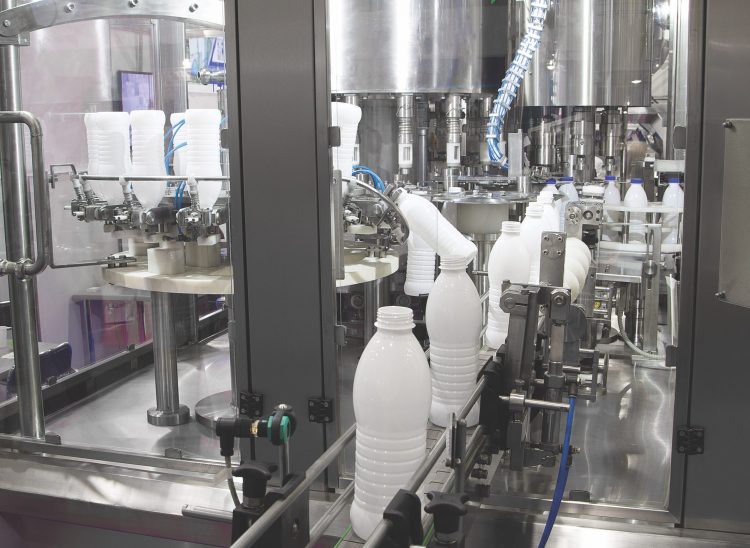Food grade lubricants – a food industry perspective
- Like
- Digg
- Del
- Tumblr
- VKontakte
- Buffer
- Love This
- Odnoklassniki
- Meneame
- Blogger
- Amazon
- Yahoo Mail
- Gmail
- AOL
- Newsvine
- HackerNews
- Evernote
- MySpace
- Mail.ru
- Viadeo
- Line
- Comments
- Yummly
- SMS
- Viber
- Telegram
- Subscribe
- Skype
- Facebook Messenger
- Kakao
- LiveJournal
- Yammer
- Edgar
- Fintel
- Mix
- Instapaper
- Copy Link
Posted: 18 August 2016 | Ricardo F Luna - Nestlé Product Technology Center | No comments yet
The aim of this article is to review the impact of Food Grade Lubricants (FGL) in the food industry and the implications for the manufacturers of FGL with ISO 21469:2006 ‘Safety of machinery-Lubricants with incidental product contact-Hygiene requirements’, as well as the compliance with relevant legislations.


The details of this International Standard (ISO 21469), as well as other supporting documents such as the European Hygienic Engineering & Design Group EHEDG Guidelines-Doc 23 –Part 1, (Code of Food Regulations) CFR 21 Part 178.3570, Council Directive 95/2/EC, JECFA database and the NSF® database, are the references to be used for the utilisation of FGL in the food and beverage industry.
The classification of FGL is described in the ISO 6743-99:2002
What is a food grade lubricant?
Food grade lubricants are potentially indirect food additives. A grease or oil can become a food additive through leaks, over lubrication, messy application during maintenance, etc.
One of the key features remembered by many users – and most of the above-mentioned documents – is the classification of food grade lubricants into three categories, or grades.
It is quite obvious that USDA/FSIS is no longer the authority in providing or assessing FGLs, in order to classify them within the previous grades. This is carried out by a private organisation, such as NSF®.
This is already a big step for any further inquiry about the specific FGL used in the manufacturing sites as well as compliance with the international standards systems (e.g. ISO 21469) and support to certification systems (e.g. NSF®, BRC Global Standards or FSSC 22000).
FGLs are already mentioned as a pre-requisite in the ISO/TS 22002-1 (Prerequisite programmes on food safety) as a ‘materials’ for food safety.
Within the technical standard ISO/TS 22002-1, as well as other documents, there is reference to ‘risks’ of being in direct or indirect contact with food (and the same requirement is associated with beverages).
From these points onwards the goals have been set with all the necessary information and requirements (from a legal point of view and compliance with internal standards) being well defined and understood by both sets of manufacturers (i.e. suppliers of FGL and food and beverages producers).
There is no discussion about the need and benefits that FGL are providing to different equipment and subparts, nor the consumer’s demand for fewer chemicals. It means that it is a big challenge for the manufacturers of food and beverages to ensure that FGL are used, whilst complying with all the rules as well as ensuring that residues (if any) are not harming consumers, according to the food safety definition by Codex Alimentarius:
Food safety – Assurance that food will not cause harm to the consumer when it is prepared and/or eaten according to its intended use.


One of the key goals of the FGL is to reduce the presence of foreign bodies.
From the ‘Food safety’ definition, it can be excluded automatically as a non-food safety issue, because it is very unlikely that a FGL could harm a consumer for the intended use.
Despite this definition, FGL are pre-requisites that must follow the Good Manufacturing Practices (GMPs) and are described in the Food Safety Management Systems, such as ISO 22000.
Within the risk assessments for each operation or step, the value quoted in Table 1 for H1 lubricant is 10mg/Kg or 10ppm.
This value can be used as a specification limit that comes from legislation during the risk assessment.
What do we mean by ‘risk assessment’?
This refers to the thorough investigation and review to ensure that the end product will not contain residues of FGL due to the normal operation of the equipment and activities surrounding them. These include (among others):
- Packaging material
- Pre lubricated components
- Bearings
- Pneumatics
- Electric panels (e.g. HMIs)
- Material handling equipment (forklifts, ladders, cranes, etc.)
Whilst carrying out the risk assessment, the ‘likelihood’ of getting a product ‘contaminated’ with more than 10ppm must be performed.
As a conclusion of the risk assessment, we can claim that there is no significant risk at this step or operation.
However, it is important to take into account the consumer’s perception and judgement. For instance, a white or clear product with a different colour (grey, black) or even cloudy, could trigger a rejection of that particular product, even if the food and beverage manufacturer can prove that the residues are below the legal limits.
In other words, it means that it is first action and good approach to assess the risks (considering the likelihood and the specifications), but this may not be sufficient as a preventive approach against a potential incident (the target is always zero).
The limits set above for a FGL such as H1 (10ppm or 10mg of FGL/kg of product) must not be the target. This value is only defined as ‘specification limit’, in order to show compliance with standards and norms. The target is always ‘zero’.
Needless to say, consumers’ perception with regard to the presence of chemicals in foods and beverages is that it is not desired. Therefore, we should not be misled by the risk assessment when the presence at acceptable levels show us that we have a no significant risk, only to have the product later rejected by consumers when there are deviations from the expected food and beverage, such as:
- (Different) colours
- Drops on the surface/residues in the bottom
- Taste/mouth feel
- Residues on dishes/mugs/glasses, etc
- Stains
Fortunately, there are no usual complaints regarding the previously mentioned reasons, but we should not wait for them. We must adopt the preventive measures.
However, one of the key goals of the FGL is to reduce or minimise the presence of foreign bodies and physical hazards in the products (together with the improved performance of some equipment and their normal function). Therefore they are absolutely necessary.
There are already some efforts to make FGL metal detectable, but this great effort is limited to the sensitivity of some metal detectors, as well as the package being used.


Performing a risk assessment helps to ensure that the end product will not contain residues of FGL.
The good practice of labelling the FGL used in particular equipment or locations is very important in order to raise the awareness of the people involved in the line, but also to ensure that the same FGL will be used next time; the outcome of the utilisation (including the needs for its change or refill); as well as showing the evidence of the FGL certified under ISO 21469 requirements.
Precision and specificity is key with FGLs
It is extremely important to review this situation, not only with the manufacturers of FGL, but with the manufacturers of the equipment as well. The working conditions must be analysed by all the people involved in order to review the intended use and the application, such as wet or dry environment, temperature, ventilations, etc.
The wrong application of FGL can deliver not only poor results or damages to the equipment, but can create the above-mentioned consumers dissatisfaction and create foreign bodies in products.
The requirements for FGL are very clear, but the requirements in the food industry, of specific FGL applications, must be assessed one by one.
For this purpose, it is highly recommended to assess each minor component of the equipment (including the electric parts and sensors) in order to at least classify the FGL accordingly (what could be ‘incidental’).
This assessment must not be limited to the ‘fixed’ equipment or parts, since movable objects such as forklifts, transport belts, chains, pulleys, etc. may use FGL and can be ‘incidental’ in contact with products.
Regular verification of the FGL composition is very difficult (if not impossible) to perform by the food industry. At best, a certificate of analysis or authenticity (COA) can be delivered by the FGL manufacturer.
Sometimes these values are included in the Material Safety Data Sheet (MSDS) and the reflection in COAs may also have their limitation, if the methods are not accredited according to ISO 17025, since it could be a debatable topic to define a “competent laboratory” as well as the value reported.
Nevertheless, we should not go so far as to request results and information that may not be relevant for the purpose. A guarantee that the FGL does not contain any contaminant, banned or unauthorised ingredient within their formula, must be sufficient. For this purpose a certification by an international standard such as ISO 21469, is recommended.
Shelf-life of FGL is required in the ISO 21469. It helps both sides (FGL manufacturer and the plants of the food industry) to keep an updated inventory, use them before the expiry date and supply the FGL according to its use (for instance, high demand or rotation).
Disposal of FGL, including their containers, is also a relevant activity for environmental protection.
Conclusion
This can be broken down into five steps: the first step (and mandatory) is to ensure that only FGL are used in manufacturing plants; the second step is to create a simple database in order to know where and what type of FGL is used; performing ‘on-site’ verification of the locations where the FGL are used is the third task; the fourth is to create an action plan, including the changes needed, timelines and clear responsibilities; and lastly, the fifth step is to review the voice of the consumers and prevent any potential issue.
About the author


Note
Definitions are detailed in the INTERNATIONAL STANDARD (IS) ISO 21469:2006. However, they cannot be reproduced due to copyrights.
Issue
Related topics
Contaminants, Equipment, Food Grade Lubricants, Food Safety, Processing, Quality analysis & quality control (QA/QC), Regulation & Legislation









